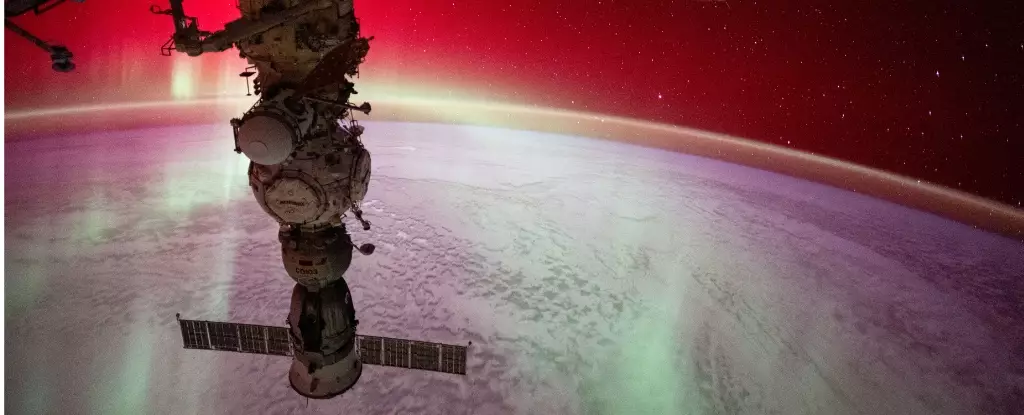The International Space Station (ISS) serves as an extraordinary vantage point, allowing astronauts to capture breathtaking photography of Earth and beyond. Every year, the station becomes the backdrop for some of the most stunning images ever seen. It is not merely the technical prowess of the astronauts behind the cameras that leads to these mesmerizing shots; it is, in fact, the unparalleled perspective offered by being 250 miles above the planet’s surface. With each orbit taking approximately 90 minutes, the astronauts are treated to a constantly shifting panorama that includes everything from shimmering auroras to colossal storm systems.
Astronauts frequently seize the opportunity to document their extraordinary surroundings, taking thousands of pictures that chronicle both the beauty and the sobering realities of our planet. NASA astronaut Matt Dominick, in an interview, articulated this sentiment, stating, “How would you not want to take pictures and try to share that with the rest of humanity?” The rich tapestry of Earth’s landscapes becomes a visual storybook that connects viewers to events happening far beyond their usual reach.
2024 arrived with exceptional moments for the ISS crew, beginning with the brilliant Comet Tsuchinshan-ATLAS. This cosmic spectacle offered a dazzling contrast against the backdrop of Earth as the astronauts captured its glow during their nightly orbits. Events like these offer a unique glimpse into the interplay between celestial phenomena and terrestrial landscapes. Additionally, the astronauts are in prime position to witness the ethereal dance of the northern lights, also known as the aurora borealis. This natural light display is not only captivating but also demonstrates the complex interactions between the Earth’s atmosphere and solar winds.
Furthermore, the space station provided astronauts with the remarkable opportunity to observe a total solar eclipse, as the shadow of the moon cast itself over the U.S. Such monumental occurrences remind us of the cosmic ballet in which our planet participates, and viewing them from space adds a layer of majesty that cameras, despite their capabilities, struggle to capture effectively. “I’ve spent a fair amount of time trying to capture what I can see with my eye. I’ve not been able to achieve it yet,” Dominick admitted, underscoring the limitations of technology compared to firsthand experience.
While the imagery captured from the ISS often emphasizes awe and splendor, it does not shy away from the stark realities of climate change and natural disasters. Observations from the station routinely reveal destructive wildfires and the expansive impact of hurricanes, such as Helene and Milton, which stretch for hundreds of miles. From a bird’s-eye view, these cataclysms are indisputable and serve as a stark reminder of Earth’s vulnerability.
Importantly, astronauts report that the vantage point above Earth fosters a significant transformation in perspective—often referred to as the “Overview Effect.” Upon witnessing the planet in its entirety from space, many express feelings of interconnectedness and the fragility of life. The actor William Shatner, who experienced this phenomenon during his spaceflight, poignantly reflected on the contrasting elements of existence witnessed from above, such as the deep blue oceans below against the vast blackness of space.
As inspiring as the ISS experience has been, the reality of its impending retirement adds a note of urgency to the astronauts’ missions. Set to conclude operations by 2030, the ISS will face decommissioning and a planned descent into the Pacific Ocean. NASA has tasked SpaceX with the crucial role of safely guiding the station out of orbit. The legacy of the ISS, as expressed by Astronaut Dominick, speaks to the significant advancements in our understanding of science and humanity’s place in the universe, achieved through this floating window to the cosmos.
In the midst of challenges, such as delays in returning to Earth for astronauts Suni Williams and Butch Wilmore aboard the Crew Dragon after the Starliner expedition, the opportunity to conduct experiments and observe the planet remains invaluable. Williams embraced her time in space, stating, “This is my happy place. I love being up here in space.”
As we celebrate the celestial wonders captured by the ISS, we must also acknowledge the role it plays in reminding us of our responsibilities to the planet below. The combination of breathtaking views and sobering realities compels humanity to strive for greater stewardship of Earth and one another.


Leave a Reply